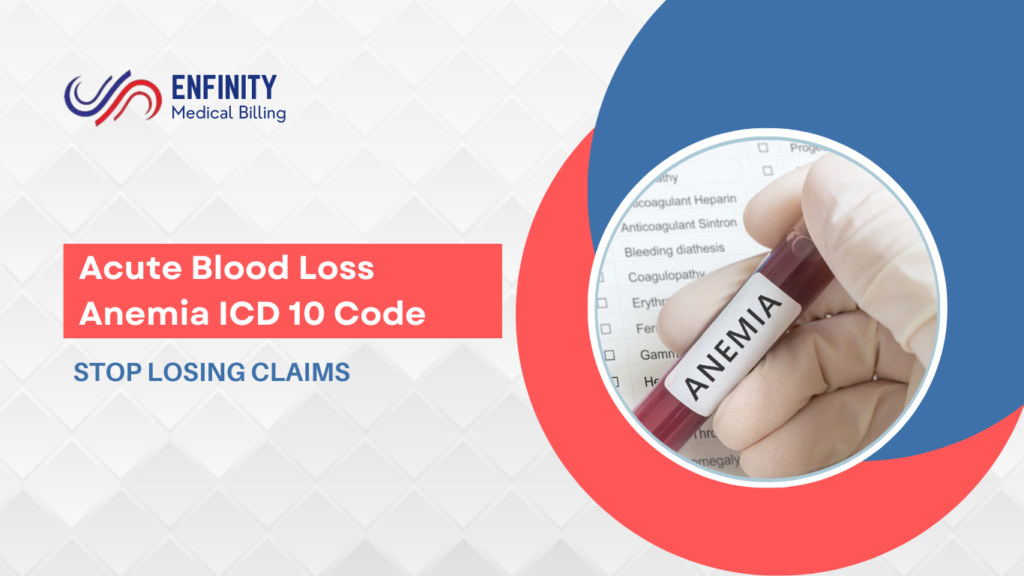Anemia is a common condition that affects millions of people worldwide. Proper medical coding using icd 10 for acute blood loss anemia is crucial for accurate diagnosis, billing, and treatment planning. In this guide, we will cover acute blood loss anemia icd code 10 , anemia in CKD ICD-10, D64.9 diagnosis code, and more. Whether you’re a healthcare provider, medical coder, or just looking for the right ICD 10 code for anemia, this guide has you covered.
Understanding Anemia and Its ICD 10 Classification
What is Acute Blood Loss Anemia?
Acute blood loss anemia is a condition where a significant amount of blood is lost in a short period, leading to reduced red blood cells. This can occur due to trauma, surgery, or internal bleeding, such as gastrointestinal hemorrhage, postpartum hemorrhage, or major surgical procedures. When excessive blood is lost, the body struggles to replenish red blood cells quickly enough, causing symptoms like dizziness, fatigue, shortness of breath, and pale skin.
What is Chronic Anemia?
Chronic anemia is a long term condition where the body does not produce enough red blood cells, often due to underlying chronic diseases like chronic kidney disease (CKD), nutritional deficiencies, or bone marrow disorders. Unlike acute anemia, which develops rapidly, chronic anemia progresses slowly, and patients may not notice symptoms until the condition becomes severe.
Difference Between Acute and Chronic Anemia
| Feature | Acute Anemia | Chronic Anemia |
| Onset | Sudden and rapid | Develops over time |
| Cause | Trauma, surgery, hemorrhage | Chronic diseases (CKD, cancer, malnutrition) |
| ICD-10 Code | D62 (Acute Blood Loss Anemia) | D63.1 (Anemia in CKD), D63.8 (Anemia of Chronic Disease), D64.9 (Unspecified Anemia) |
| Symptoms | Rapid heartbeat, dizziness, pale skin, low blood pressure | Fatigue, weakness, pale skin, shortness of breath |
| Treatment | Blood transfusions, iron therapy, controlling bleeding | Treat underlying condition, iron/B12 supplementation, erythropoietin (for CKD patients) |
Symptoms of Acute Blood Loss Anemia
Anemia symptoms vary depending on the type and severity of the condition. However, common symptoms include:
- Fatigue and Weakness – Due to insufficient oxygen delivery to tissues.
- Pale or Yellowish Skin – A sign of reduced red blood cell count.
- Shortness of Breath – Even with mild exertion.
- Dizziness or Lightheadedness – Caused by decreased oxygen to the brain.
- Cold Hands and Feet – Poor circulation from low hemoglobin levels.
- Irregular Heartbeat (Palpitations) – The heart works harder to compensate for low oxygen levels.
- Headaches – Common in chronic anemia cases.
Early recognition of these symptoms helps in timely diagnosis and treatment.
How is Anemia Diagnosed and Treated?
Diagnosis of Anemia
Anemia is diagnosed through a combination of blood tests, including:
- Complete Blood Count (CBC) to measure hemoglobin and hematocrit levels
- Serum ferritin and iron levels to check for iron deficiency
- Vitamin B12 and folate levels to identify nutritional deficiencies
- Reticulocyte count to assess bone marrow function
Treatment of Anemia
Treatment depends on the underlying cause and severity of anemia. Common approaches include:
- Iron supplements for iron deficiency anemia
- Vitamin B12 or folate supplementation for macrocytic anemia
- Blood transfusions for severe acute blood loss anemia
- Erythropoietin stimulating agents (ESAs) for anemia due to CKD
- Managing underlying conditions like CKD or chronic renal failure
ICD 10 Codes for Different Types of Anemia
Anemia ICD code 10: A Quick Reference Guide
- D62 – ICD 10 for Acute Blood Loss Anemia: Used for acute posthemorrhagic anemia caused by sudden blood loss from trauma, surgery, or gastrointestinal bleeding.
- D63.8 – Anemia of Chronic Disease: Applied when anemia is linked to chronic conditions such as cancer, infections, or inflammatory diseases.
- D50 – Iron Deficiency Anemia: Covers anemia due to low iron levels, often caused by malnutrition, heavy menstrual bleeding, or gastrointestinal disorders.
- D55-D58 – Macrocytic Anemia: Encompasses cases where red blood cells are larger than normal, often due to vitamin B12 or folate deficiency.
- O99.0 – Anemia in Pregnancy: Used for anemia during pregnancy, which occurs due to increased blood volume and higher iron demand. The trimester and severity must be considered.
- Z13.0 – Screening for Anemia: Assigned for preventive anemia screenings, especially in high-risk groups such as pregnant women and elderly individuals.
- D64.9 – Unspecified Anemia: Used when anemia is diagnosed but the specific type is not documented in the medical record.
Different Categories of ICD 10 Code For Anemia
Iron Deficiency Category
| D50 Category | |
| D50.0 | Iron deficiency anemia secondary to blood loss (chronic) |
| D50.1 | Sideropenic dysphagia |
| D50.8 | Other iron deficiency anemias |
| D50.9 | Iron deficiency anemia, unspecified |
Vitamin Deficiency Anemia
| D51 Category (Vitamin B12 deficiency anemia) | |
| D51 | Vitamin B12 deficiency anemia |
| D51.0 | Vitamin B12 deficiency anemia due to intrinsic factor deficiency |
| D51.1 | Vitamin B12 deficiency anemia due to selective vitamin B12 malabsorption with proteinuria |
| D51.3 | Other dietary vitamin B12 deficiency anemia |
| D51.8 | Other vitamin B12 deficiency anemias |
| D51.9 | Vitamin B12 deficiency anemia, unspecified |
| D52 Category ( Folate Deficiency Anemia) | |
| D52 | Dietary folate deficiency anemia |
| D52.1 | Drug-induced folate deficiency anemia |
| D52.8 | Other folate deficiency anemias |
| D52.9 | Folate deficiency anemia, unspecified |
Hemolytic anemia
| D55 Category (Anemia Due To Enzyme Disorder) | |
| D55.0 | Anemia due to deficiency of glucose-6-phosphate dehydrogenase |
| D55.1 | Anemia due to other disorders of glutathione metabolism |
| D55.21 | Anemia due to pyruvate kinase deficiency |
| D55.3 | Anemia due to disorders of nucleotide metabolism |
| D55.8 | Other anemias due to enzyme disorders |
| D55.9 | Anemia due to enzyme disorder, unspecified |
| D56 Category (Thalassemia) | |
| D56.0 | Alpha thalassemia |
| D56.1 | Beta thalassemia |
| D56.2 | Delta-beta thalassemia |
| D56.3 | Thalassemia minor |
| D56.4 | Hereditary persistence of fetal hemoglobin [HPFH] |
| D56.5 | Hemoglobin E-beta thalassemia |
| D56.8 | Other Thalassemia |
| D56.9 | Thalassemia, Unspecified |
| D57 Category (Sickle Cell Disorder) | |
| D57.0 | HB SS Disease with crisis |
| D57.1 | Sickle-cell disease without crisis |
| D57.2 | Sickle-cell/Hb-C disease |
| D57.3 | Sickle-cell trait |
| D57.4 | Sickle-cell thalassemia |
| D57.8 | Other sickle-cell disorders |
Aplastic anemia
| D61 Category | |
| D61.0 | Constitutional aplastic anemia |
| D61.1 | Drug-induced aplastic anemia |
| D61.2 | Aplastic anemia due to other external agents |
| D61.3 | Idiopathic aplastic anemia |
| D61.8 | Other specified aplastic anemias and other bone marrow failure syndromes |
| D61.9 | Aplastic anemia, unspecified |
Anemia in Chronic Kidney Disease (CKD) and ESRD
What is Anemia of Chronic Kidney Disease?
Anemia in CKD is common due to reduced erythropoietin (EPO) production, which affects red blood cell formation.
ICD 10 Code for Anemia in CKD (D63.1)
This code is specifically used for anemia caused by chronic kidney disease, helping in medical claims and treatment planning.
How to Code Anemia in ESRD (End-Stage Renal Disease)?
Patients with ESRD often require erythropoiesis-stimulating agents (ESAs) and iron supplements to manage anemia. Coding must indicate CKD stage severity.
Chronic Anemia vs. Acute Anemia in CKD: Key Differences
- Chronic anemia in CKD is progressive and requires ongoing management.
- Acute anemia in CKD can occur due to sudden gastrointestinal bleeding or blood loss from dialysis complications.
The Link Between Anemia and Chronic Renal Failure
Anemia worsens chronic renal failure symptoms, leading to fatigue, shortness of breath, and reduced exercise tolerance.
ICD-10 Coding Guidelines & Best Practices for Anemia
Accurate ICD-10 coding for anemia is essential for proper medical documentation, insurance claims, and effective patient care. Since anemia can result from various underlying conditions, following the correct coding guidelines ensures compliance and reimbursement.
- ICD-10 Coding Guidelines for Anemia: Always assign the most specific anemia code available. Some commonly used ICD-10 codes include:
- D50.0 – Iron deficiency anemia secondary to blood loss (chronic)
- D51.0 – Vitamin B12 deficiency anemia (pernicious anemia)
- D55.0 – Anemia due to G6PD deficiency
- D57.0 – Sickle-cell anemia with crisis
- D63.1 – Anemia in chronic kidney disease (CKD)
- D64.9 – Anemia, unspecified
- Link Anemia to Underlying Conditions: When anemia is due to an underlying disease, it’s essential to report both the anemia code and the primary condition:
- Anemia due to chronic kidney disease (CKD): Code D63.1 (Anemia in CKD) + appropriate CKD stage (N18.1-N18.6)
- Anemia due to malignancy: Code D63.0 (Anemia in neoplastic disease) + the specific cancer diagnosis
- Anemia due to chemotherapy or radiation therapy
- Code D64.81 (Anemia due to antineoplastic chemotherapy)
- Code Y84.2 if radiation-induced
- Anemia in Pregnancy and Postpartum: For anemia during pregnancy or postpartum, assign the appropriate O99.0 series codes along with the anemia code:
- O99.02 – Anemia in pregnancy, second trimester + specific anemia type (e.g., D50.9 for iron deficiency anemia)
- O99.03 – Anemia in pregnancy, third trimester
- O99.08 – Anemia in the postpartum period
- Postoperative and Acute Blood Loss Anemia ICD 10 Code: Anemia following surgery or acute bleeding requires proper documentation:
- D62 – Acute posthemorrhagic anemia (used for anemia after significant blood loss due to surgery, trauma, or internal bleeding)
- D64.9 – Use only if the provider does not specify the anemia type
Best Practices for ICD-10 Anemia Coding
- Ensure Provider Documentation is Specific: Clarify whether anemia is due to nutritional deficiency, chronic disease, blood loss, or bone marrow disorders.
- Sequence Codes Correctly: When anemia is secondary to another condition, list the underlying cause first, followed by the anemia code.
- Use Additional Codes if Necessary: If anemia is caused by an external factor (e.g., chemotherapy, radiation), include the appropriate Y-code for external causes.
- Avoid Unspecified Codes When Possible: D64.9 (Unspecified anemia) should be avoided if a more precise code is available.
- Stay Updated on Coding Changes: ICD-10 codes are periodically updated, so refer to the latest CMS and WHO guidelines to ensure compliance.
Conclusion
Correctly coding anemia with ICD-10 codes is essential for accurate medical documentation, billing, and treatment planning. Whether it’s Acute Blood Loss Anemia ICD 10 Code (D62), anemia in CKD ICD-10 (D63.1), or chronic anemia unspecified ICD-10 (D64.9), proper coding ensures patients receive the right treatment and providers receive correct reimbursements.






